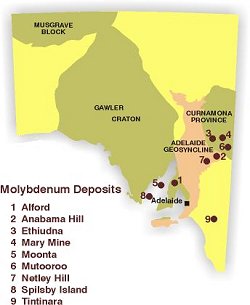 Molybdenum was discovered in 1778 by Swedish chemist Carl Milhelm Scheele, and obtained its name from the Greek word molybos, meaning lead like. It is a silvery white, tough, malleable metal and most commonly occurs in nature as molybdenite (MoS2) and wulfenite (PbMoO4). It is an important trace element in soils for plant growth.
Molybdenum was discovered in 1778 by Swedish chemist Carl Milhelm Scheele, and obtained its name from the Greek word molybos, meaning lead like. It is a silvery white, tough, malleable metal and most commonly occurs in nature as molybdenite (MoS2) and wulfenite (PbMoO4). It is an important trace element in soils for plant growth.
Molybdenum is chiefly used in steel making for the production of alloys that are strong and withstand high temperatures and pressures. The alloys are used for structural work, aircraft parts and forged automobile parts. Molybdenite is widely used as a lubricant in high-temperature environments. Molybdenum wire is used in electron tubes, and molybdenum electrodes are used in glass furnaces.
The annual world production of 270 000 tonnes of molybdenum, in 2013, was mined from porphyry style deposits as a primary mineral and sourced as a by-product or co-product of copper production.
The major producers are China (41%), USA ((23%), Chile (13.5%) and Peru (6.3%). There was no recorded production of molybdenum in Australia in 2012 but demonstrated resources are present in Western Australia, Queensland, Victoria and New South wales.
South Australia has produced small quantities of molybdenite from the southeastern Gawler Craton (Yorke Peninsula) where it is associated with Cu–Au mineralisation at the Moonta, Yelta, Wallaroo and Kurilla Mines. The Yelta Mine, in particular, has a recorded production of 960 kg of molybdenite, in the early 1900s, as hand-picked material from the Cu–Au ore. Actual production may have been several tonnes.
The host rock for the Moonta and Yelta deposits is the Palaeoproterozoic Moonta Porphyry, while the Wallaroo and Kurilla deposits are hosted by the Palaeoproterozoic Doora Metasediments. Mineralisation may be related to Mesoproterozoic igneous activity.
Significant amounts of molybdenite have been found at the Alford prospect where Cu–Au–Mo mineralisation is associated with porphyry style alteration of a Mesoproterozoic diorite body and metasedimentary roof rocks.
A resource of molybdenite is present on Spilsby Island, the largest of the Sir Joseph Banks Group in Spencer Gulf, where an indicated 250 000 t of 0.25% combined molybdenite and scheelite (tungsten) have been outlined. Mineralisation occurs as pods, disseminations and in quartz veins within a shallow-dipping zone hosted by a Mesoproterozoic medium-grained, magmatic-layered granite.
In the Curnamona Province, disseminated molybdenite occurs within porphyry style altered Ordovician granite at Anabama Hill and Netley Hill prospects. Drilling has intersected up to 0.2% Mo and 0.15% Cu. Minor molybdenite has also been recorded at the Mutooroo Mine (Cu), Benowrie Copper Mine (Mary Mine) and Ethiudna Mine (Cu–Co–Ni). An inferred resource of 4.5 Mt at 0.06% Mo is present at the Kalkaroo Cu-Au-Mo Prospect.
Coarse molybdenite occurs in narrow veinlets (10 mm) within Ordovician granite at a quarry near Tintinara in the South-East of the State.
Additional Reading
Daly, S.J., Fanning, C.M. and Fairclough, M.C., 1998. Tectonic evolution and exploration potential of the Gawler Craton, South Australia. AGSO Journal of Australian Geology and Geophysics, 17(3):145-168.
Morris, B.J., 1981. Porphyry style copper–molybdenum mineralisation at Anabama Hill. Mineral Resources Review, South Australia, 150:5-24.
Miller, P.G., 1970. Spilsby Island molybdenite–scheelite deposit. Mineral Resources Review, South Australia, 132:81-88.


